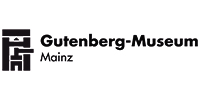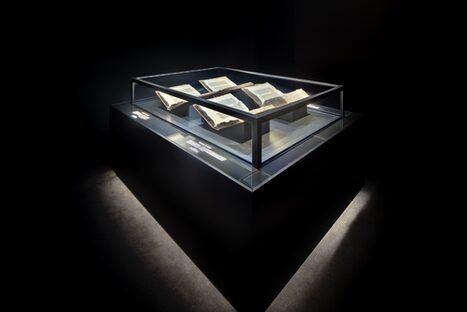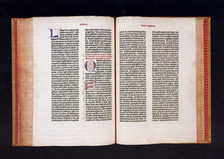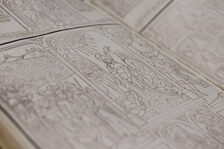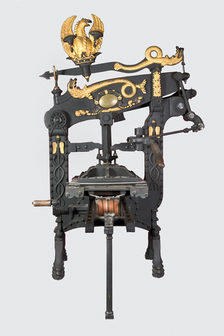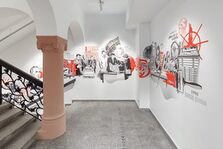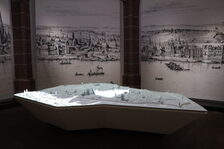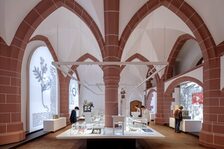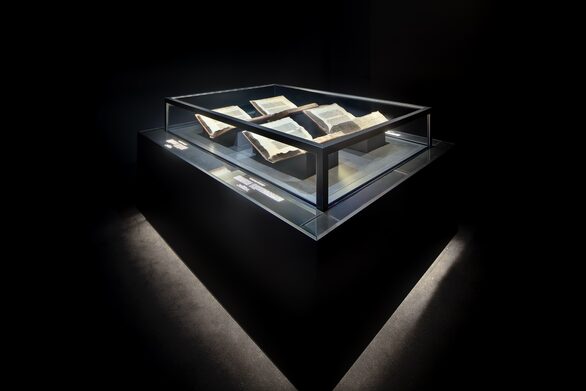Highlights
The permanent exhibition is rich in treasures and stories. You should definitely not miss it!
1. The Gutenberg Bibles in the vault
The central exhibits of the collection and possibly its main treasures can be found in the vault of the permanent exhibition – two bibles from the workshop of Johannes Gutenberg. Both the complete two-volume Shuckburgh copy (1452-55), as well as a volume of the Laubach copy (1452-55) can be admired and compared in the vault.
To this day, the Bibles constitute the "magnum opus" of Johannes Gutenberg's work. Gutenberg's method of letterpress printing with movable type was implemented with exceptional quality in this work. The development of letterpress printing subsequently led to a veritable revolution for the sciences, economy, and culture, serving as a milestone of the modern era and human history.
To this day, the Gutenberg Bible is considered to be among the world's most beautiful printed books.
Location: Ground floor, Treasury
2. The block book
The Gutenberg Museum now owns three different block books, which are important testimonies to the experimental phase of early book printing. One of them is the Biblia Pauperum, also known as the “Poor Man's Bible”. The 40-page block book was probably produced in southern Germany around 1460-64. Block books date from the period of transition from manuscript culture to book printing and are of particular cultural and historical value. For block books, motifs and text were usually carved together on a wooden block and printed onto the paper. In contrast to Gutenberg's invention of printing with individual movable type, the production of block books involved much more effort and was not successful in the long term. The printing blocks had to be painstakingly carved for individual pages, and errors in them were almost impossible to correct. Even if block books were produced using a reproduction process, only a few editions have survived, often incomplete. They are even more rarely offered for sale. The newly acquired Biblia Pauperum is one of the few complete versions and is characterized by its outstanding state of preservation. The Biblia Pauperum purchased for the Gutenberg Museum is particularly valuable and unique in Germany due to the completeness of its pages and its excellent, uncolored condition. Its provenance can be traced back to the first half of the 19th century.
Location: Ground floor, Treasury
3. The Gutenberg workshop
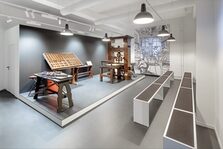
In 1925, for the first time a reconstructed "Gutenberg workshop" was set up, and quickly evolved into one of the museum's main attractions. At the workshop premises in the basement of the Gutenberg Museum, type casting, type setting and printing on the wooden Gutenberg printing press is demonstrated descriptively and expertly to this day.
The reconstructed Gutenberg printing press is based on woodcuttings from the 15th and 16th century. There are hourly demonstrations at the Gutenberg workshop throughout the year. For comprehensive information, see the section Regular events.
Location: 1st floor
4. The "Columbian Press" of 1824
In the late 18th century construction of the first full metal printing presses commenced. Their sturdy design allowed printing even very heavy forms using a lever bar. Following Wilhelm Haas (Basel 1772) and the Earl of Stanhope (London around 1800) in 1810 the US citizen George Clymer succeeded in building such a printing press. His "Columbian Press" reduced the effort required for printing to such a degree that even children could operate the press, as the advertising rightfully claimed.
In addition to this work facilitation for printers the "Columbian" also boasted a magnificent exterior, which played a significant part in the success and popularity of this printing press. For example, the counterweight on the upper lever is designed as a bald eagle with two ink balls, the heraldic animal of the letterpress printers' guild. In 1817 George Clymer was granted a patent in England and started to build and sell his presses from there to the European market. The Columbian press in the Gutenberg Museum is one of the few printing presses that were manufactured under license in Germany at the steel works of the city of Zorge. In combination with the inking of the print forms with hand rollers instead of the former ink balls, the press increased the hourly output to 300 to 400 prints.
Location: Ground floor
5. Picture journey
The pictorial journey illustrated by Jörn Kaspuhl shows the history of the Gutenberg Museum and its significance for the city of Mainz. Important milestones, such as the founding of the museum in 1900 and the visit of Queen Elizabeth II in 1978, vividly illustrate the development of the Gutenberg Museum into a hotspot for special personalities and give the viewer an impression of how lively the World Museum of Printing Art is as a place of encounter.
Location: Staircase
6. City model
The new city model shows Gutenberg's most important places of activity in medieval Mainz. Built as a 3D model, it also features a projection about Gutenberg's life.
A “blank page” from the museum's collection guides visitors through this journey through time as a narrator and animation.
Location: Ground floor
7. The Gutenberg Museum: A media-historical perspective
In the nave, the largest exhibition space, six thematic areas are presented based on today's media and their use: “Describing the world”, “Passing time”, “Making opinions”, “Unfolding splendor”, “Creating knowledge” and “Cultivating image”. An object from the Gutenberg Museum's collection is assigned to each topic area in order to compare media developments of the past and present. At the interactive selfie station, visitors can create a self-portrait in the setting of a printing workshop; this is then printed on a media card. Our guests can also place the media cards under various media stations that provide further information about the exhibition.
Location: 2nd floor, East Asia section
